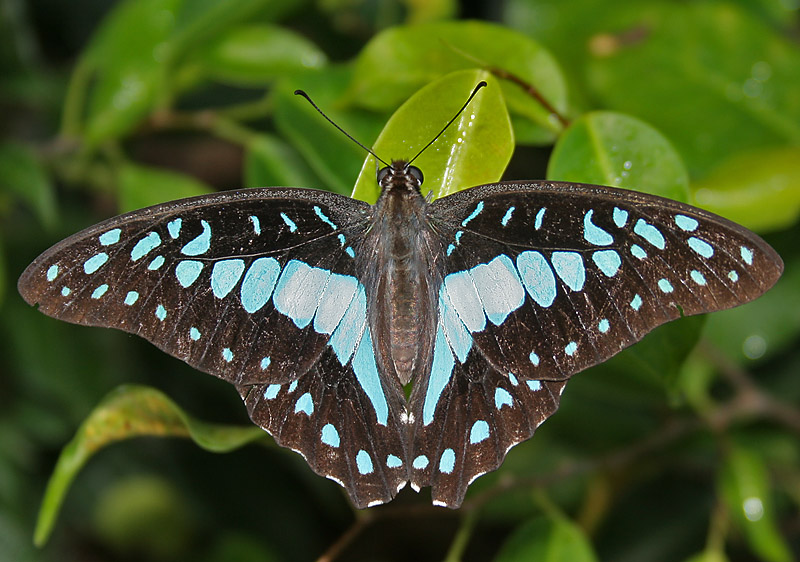
Graphium doson (Graphium doson)
Phylum — arthropoda
Class — insecta
Order — lepidoptera
Family — papilionidae
Genus – graphium
Appearance
The caterpillar is somewhat spindle shaped. The grown caterpillars have two forms, dark brown or grassy green. There are spines on the fourth segment which are short, conical and blue centered surrounded by lemon yellow and then black rings. The osmeterium is pale bluish green.
Wingspan ranges from 70 to 80 mm. The sexes are alike. The forewing is elongated with a concaved outer margin; the hindwing is serrated at the outer margin but it has no tail. This butterfly’s upper side is black in color, with a median light blue band and sub-marginal row of spots on both wings. The forewing cell bears some blue markings. The background color is much duller on the underside, and the blue markings appear enlarged due to the pale outline. Its hindwing has red markings, including a stripe along the inner margin.
Habitat
It is widespread and common throughout Southeast Asia, including lower elevations in Sri Lanka and southern India, Eastern Ghats, Satpuras, Bengal, Assam and Bangladesh, and the Himalayan foothills.
Behavior
Graphium doson is active throughout the day and constantly on the move; it rarely settles down. Its flight is swift and straight. When feeding from flowers, it never settles down and keeps its wings vibrating. The males are seen mud-puddling, often in tight groups. Usually all the butterflies in the cluster are turned in one direction-towards the wind.
Like other caterpillars of this family, the caterpillar of this butterfly has an osmetrium – a gland behind the head that extends in danger and looks like two long orange-red "horns".
Diet
The caterpillars feed on plants of the families Annonaceae, Lauraceae and Magnoliaceae such as Annona lawii, Cinnamomum macrocarpum, Magnolia grandiflora, Michelia champaca, Milliusa tomentosum and Polyalthia longifolia.
Reproduction
For their reproduction you need a terrarium with a size of 50 x 50 x 70 cm. The spherical and pale yellow eggs are laid singly on the underside of leaves. Each butterfly lays more than 100 eggs. The eggs are creamy-white, globular, about 1 mm in diameter. The incubation period is 3-4 days. Between feedings the caterpillars sit on the upper surface of the leaf near the midrib. It is better to keep the caterpillars in containers with a mesh lid of 6-8 pieces. In the container, you need to place a forage plant. The temperature is 23-25 oC at the humidity of 65-75 %. The caterpillar develops for 18-20 days. The pupa is pale green with a dark purplish median line from the head to the thoracic horn and a yellow line from the tip of the horn to the cremaster. The pupa stage lasts for 8-15 days. The butterflies hatch in the morning. The butterfly lives up to 14 days.
In captivity
The mesh terrarium with a size of 50 × 50 × 70 mm is suitable for keeping butterflies. Room temperature is necessary. Daylight time is 12 hours. You can feed the butterflies with honey syrup diluted with boiled water in a ratio of 1: 10.
 Russian
Russian
 English
English


















